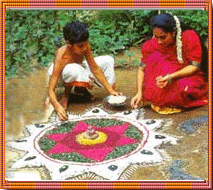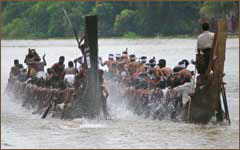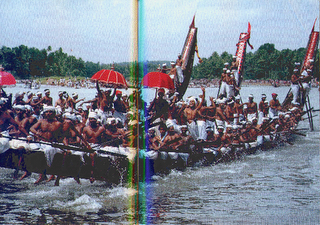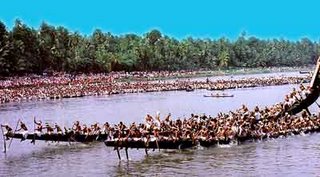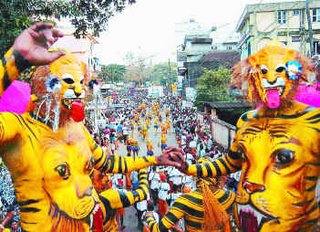Pookalam 
Pookalam is an intricate and colourful arrangement of flowers laid on the floor. Tradition of decorating Pookalam is extremely popular in Kerala and is followed as a ritual in every household during ten-day-long Onam celebrations.
'Pookhalam' consists of two words,
'poov' meaning flower and
'kalam' means colour sketches on the ground. It is considered auspicious to prepare Pookalam, also known as
'Aththa-Poo' during the festival of Onam.
People believe the spirit of their dear King Mahabali visits Kerala at the time of Onam. Besides making several other arrangements, people, especially adolescent girls prepare elaborate Pookalams to welcome their most loved King.
Making of a PookalamKilo and kilos of flowers, lot of dedication, creativity, technique and team effort are the basic essential of an eye catching Pookkalam.
Athapoovu are usually circular in shape and multi-tiered colourful arrangements of flowers, petals and leaves. Use of powder colours, desiccated coconut or artificial flowers is prohibited. Pookalams are normally laid on the front court yard of the house. Idols of Mahabali and Vishnu are placed in the center of the Pookalam and worshiped. Diameter of a Pookalam normally ranges from four to five meters.

Ritual of making the flower mats continues for all ten days of Onam. Designing starts from the day of Atham and is made ready by Thiruvonam day. Basic design is prepared on the first day. Size of a Pookalam is increased by adding more to it on every passing day hence a massive Pookalam gets ready for the main day of the occasion. Its a big creative task, as designers have to think of a new design ever day.
Various flowers are used on each day as a specific flower is dedicated to each day of Onam. Commonly used flowers include Thumba (Lucas Aspera), Kakka Poovu, Thechipoovu, Mukkutti (little tree plant), Chemparathy (shoe flower), Aripoo or Konginipoo (Lantana), Hanuman Kireedom (Red pagoda plant) and Chethi (Ixora). Of all these flowers, Thumba flowers are given more importance in Pookalam as they are small in size and glitter in the the soft rays of the sun.
'Thumba Poo' is also considered to be the favourite flower of Lord Shiva and King Mahabali was a devout worshipper of Shiva.
On the next day of Onam, Thumba flowers are used to decorate Onapookalam. The arrangement is not touched for the next 15 days. On the 15 th day, called
'Ayilyam', Pookalam is decorated again. On the next day, called
Magam, Pookalam is given a cut in its four corners with a knife. This marks the end of Pookalam decorations for the year. Some also follow the tradition of erecting a small pandal over the completed flower carpet and decorating it with colourful festoons.
Making of Pookalam is itself a colourful and joyous event. Being a team effort it helps to generate feeling of togetherness and goodwill amongst the people. It is animating to watch women as they prepare Pookalam while singing traditional songs. Giggling and sharing jokes between the thought provoking and back breaking job.
 Trends
TrendsEarlier, people used to make efforts to collect flowers for designing a Pookalam. Children used to get up early in the morning and gather flowers in their small 'Pookuda' (basket) from the village gardens. These days, the trend has changed and people have the option of buying flowers from the market in the shape and colour of their choice.
Pookalam decoration competitions are organised by various societies and groups all over the state on the day of Onam. They have become extremely popular and witness huge public participations. Big prizes are also kept in these contests as they have turned up to be extremely competitive events. A large number of people assemble just to have a look at the innovative and meticulously prepared art pieces.
A beautiful design, though it is said, is created in the heart, use of technology is also in vogue in designing of a Pookalam. People prepare design first on computer and then implement it on floor. This saves a lot of time and energy and helps the designers to come up with stunning Pookalams.
MORE ONA-POOKALAM


